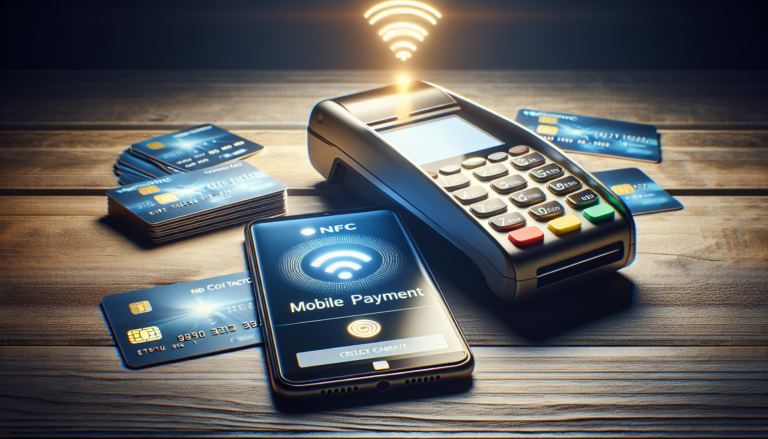In today’s fast-paced, digital world, contactless payment methods have become increasingly popular, offering speed, convenience, and enhanced security. Among these, NFC (Near Field Communication) mobile payments have emerged as a leading technology, revolutionizing the way we conduct transactions. This comprehensive guide will delve into the world of NFC mobile payments, explaining what they are, how they work, and their benefits for both consumers and businesses.
NFC mobile payments enable customers to make purchases using their mobile devices or NFC-enabled credit cards by simply tapping them on compatible card readers. This technology has gained significant traction in various industries, including retail, restaurants, and services, due to its quick, secure, and convenient nature. As we explore the intricacies of NFC mobile payments, we’ll also discuss popular platforms, security features, challenges, and the future of this innovative payment method.
Introduction to NFC Mobile Payment
NFC mobile payment is a contactless payment method that allows customers to make transactions using their smartphones or other NFC-enabled devices. By simply tapping their device on an NFC-compatible payment terminal, users can quickly and securely complete purchases without the need for physical cash or credit cards. This technology has gained significant popularity in recent years, offering a convenient and hygienic alternative to traditional payment methods.
The adoption of NFC mobile payments has been driven by the increasing use of smartphones and the growing demand for quick, secure, and seamless transactions. As more businesses embrace this technology and consumers become familiar with its benefits, NFC mobile payments are poised to become a dominant force in the world of digital transactions.
What is NFC?
NFC, which stands for Near Field Communication, is a short-range wireless technology that enables communication between two devices when they are held in close proximity to each other, typically within a few centimeters. This technology operates on the same principle as RFID (Radio-Frequency Identification) but is designed for use in mobile devices such as smartphones and tablets.
NFC technology enables various applications, including data transfer, device pairing, and, most notably, contactless payments. When used for mobile payments, NFC allows a user’s device to communicate with a compatible payment terminal, securely transmitting payment information and completing the transaction without the need for physical contact.
How NFC Mobile Payments Work
NFC mobile payments are facilitated by digital wallets, which store a user’s payment information, such as credit card details, on their mobile device. To make a payment, the user simply holds their NFC-enabled device near a compatible payment terminal, and the transaction is completed wirelessly.
When an NFC transaction is initiated, the user’s device and the payment terminal establish a secure, encrypted connection. The user’s payment information is then transmitted to the terminal, which processes the transaction and sends a confirmation back to the device. This entire process takes place within seconds, making NFC mobile payments a quick and efficient option for both consumers and merchants.
To ensure security, NFC mobile payments employ various measures such as tokenization, dynamic encryption, and biometric authentication. These features protect sensitive information and prevent unauthorized access, giving users peace of mind when conducting transactions.
Popular NFC Mobile Payment Platforms
Several major tech companies have developed their own NFC mobile payment platforms, each offering unique features and benefits. These platforms have gained widespread adoption among consumers and are accepted at a growing number of retailers worldwide. Let’s take a closer look at some of the most popular NFC mobile payment options:
Apple Pay
Apple Pay is a digital wallet and mobile payment service developed by Apple Inc. for iOS devices, including iPhones, iPads, and Apple Watches. Launched in 2014, Apple Pay allows users to store their credit card, debit card, and loyalty card information on their devices and make payments using NFC technology.
To use Apple Pay, users simply add their payment cards to the Wallet app on their device. When making a purchase, they hold their device near an NFC-enabled payment terminal and authenticate the transaction using Touch ID or Face ID. Apple Pay is accepted at millions of stores worldwide and has become one of the most widely used NFC mobile payment platforms.
Google Pay
Google Pay is a digital wallet and mobile payment service developed by Google, available on Android devices and select iOS devices. Like Apple Pay, Google Pay allows users to store their payment information and make transactions using NFC technology.
Users can add their credit cards, debit cards, and loyalty cards to the Google Pay app, which securely stores the information. To make a payment, users hold their device near an NFC-compatible terminal and authenticate the transaction using their device’s screen lock or biometric authentication. Google Pay is accepted at numerous retailers, both online and in-store, making it a convenient option for Android users.
Samsung Pay
Samsung Pay is a mobile payment and digital wallet service developed by Samsung Electronics for its Galaxy line of smartphones and smartwatches. In addition to NFC technology, Samsung Pay also supports MST (Magnetic Secure Transmission), which allows it to work with traditional magnetic stripe payment terminals.
To use Samsung Pay, users add their payment cards to the app and authenticate transactions using their device’s biometric authentication or PIN. Samsung Pay’s compatibility with both NFC and MST terminals makes it a versatile option for users, as it can be used at a wider range of retailers compared to other NFC-only payment platforms.
Security Features of NFC Mobile Payments
One of the primary concerns surrounding NFC mobile payments is security. To address these concerns, NFC payment platforms employ various security measures to protect users’ sensitive information and prevent unauthorized transactions. Let’s explore some of the key security features that make NFC mobile payments a safe and reliable option:
Biometric Authentication
Most NFC mobile payment platforms require users to authenticate transactions using biometric data, such as fingerprints or facial recognition. This added layer of security ensures that only the device owner can authorize payments, minimizing the risk of unauthorized access.
Biometric authentication is a quick and convenient way to verify a user’s identity, as it does not require remembering complex passwords or PINs. By using unique biological characteristics, biometric authentication provides a high level of security and helps prevent fraudulent transactions.
Dynamic Encryption
NFC mobile payments use dynamic encryption to protect sensitive information during transactions. Dynamic encryption generates a unique, one-time code for each transaction, making it virtually impossible for hackers to intercept or replicate payment data.
This encryption method ensures that even if a hacker manages to access the transaction data, they would not be able to use it for future purchases. Dynamic encryption is a robust security measure that helps maintain the integrity of NFC mobile payments and protects users’ financial information.
Tokenization
Tokenization is another security feature employed by NFC mobile payment platforms to safeguard users’ sensitive data. When a user adds their payment card to a digital wallet, the actual card number is replaced with a unique digital identifier, known as a token.
During transactions, the token is used instead of the real card number, adding an extra layer of security. If a hacker were to intercept the token, they would not be able to access the user’s actual payment information. Tokenization helps protect users’ data and reduces the risk of fraud and identity theft.
These security measures, combined with the inherent security of NFC technology, make NFC mobile payments a safe and reliable option for both consumers and businesses. As technology continues to evolve, we can expect even more advanced security features to be implemented, further enhancing the protection of users’ financial information.
Benefits of NFC Mobile Payments
NFC mobile payments offer a range of benefits for both consumers and businesses, making them an attractive alternative to traditional payment methods. From increased speed and convenience to enhanced security and improved hygiene, NFC technology has the potential to revolutionize the way we conduct transactions. Let’s explore some of the key advantages of NFC mobile payments:
Speed and Convenience
One of the most significant benefits of NFC mobile payments is the speed and convenience they offer. With just a simple tap of their device, users can complete transactions in seconds, eliminating the need to fumble with cash or swipe credit cards. This streamlined process not only saves time for consumers but also helps businesses reduce queue times and improve overall efficiency.
NFC mobile payments also eliminate the need to carry physical wallets or purses, as all payment information is securely stored on the user’s device. This added convenience allows users to make purchases on the go, without worrying about forgetting their wallet or running out of cash.
Enhanced User Experience
NFC mobile payments provide a seamless and intuitive user experience, making the payment process more enjoyable for consumers. With clear prompts and easy-to-follow steps, users can quickly and confidently complete transactions, even if they are new to the technology.
Digital wallets associated with NFC mobile payments often offer additional features, such as the ability to store loyalty cards, coupons, and receipts. These features enhance the overall user experience by providing a centralized hub for managing various aspects of the shopping journey.
Hygiene and Safety
In light of recent global health concerns, NFC mobile payments have gained even more attention due to their contactless nature. By allowing users to make payments without physically touching payment terminals or exchanging cash, NFC technology helps minimize the spread of germs and viruses.
This hygienic aspect of NFC mobile payments has become increasingly important for both consumers and businesses, as it helps create a safer shopping environment. As contactless payments continue to gain popularity, NFC technology is well-positioned to meet the growing demand for hygienic and secure transaction methods.
In addition to these benefits, NFC mobile payments also offer increased security compared to traditional payment methods. With features like biometric authentication, dynamic encryption, and tokenization, NFC technology helps protect users’ sensitive information and reduces the risk of fraud and identity theft.
Challenges and Considerations
While NFC mobile payments offer numerous benefits, there are also some challenges and considerations that users and businesses should be aware of. Understanding these potential hurdles can help ensure a smooth transition to NFC technology and maximize its advantages. Let’s take a look at some of the key challenges and considerations surrounding NFC mobile payments:
Hardware Compatibility
One of the main challenges facing NFC mobile payments is hardware compatibility. For users to take advantage of this technology, they need to have an NFC-enabled device, such as a smartphone or smartwatch. While many modern devices come equipped with NFC capabilities, older models may not support this feature, limiting the adoption of NFC mobile payments.
Similarly, businesses need to invest in NFC-compatible payment terminals to accept NFC transactions. While the number of NFC-enabled terminals is growing, some businesses may still rely on older, non-compatible equipment, which can hinder the widespread use of NFC mobile payments.
Security Concerns
Although NFC mobile payments employ various security measures, such as biometric authentication, dynamic encryption, and tokenization, some users may still have concerns about the safety of their financial information. These concerns can stem from a lack of understanding about how NFC technology works or from previous experiences with data breaches or identity theft.
To address these concerns, it is essential for NFC mobile payment providers and businesses to educate users about the security features in place and to continually update and improve these measures to stay ahead of potential threats. Building trust and confidence in NFC technology is crucial for driving widespread adoption.
Consumer Education
Another challenge facing NFC mobile payments is the need for consumer education. While the technology itself is relatively simple to use, some users may be hesitant to adopt NFC payments due to a lack of familiarity or understanding of how they work.
To overcome this challenge, businesses and NFC mobile payment providers need to invest in consumer education initiatives, such as tutorials, demonstrations, and marketing campaigns. By clearly communicating the benefits and ease of use of NFC technology, these efforts can help build consumer confidence and encourage adoption.
Additionally, businesses can play a role in promoting NFC mobile payments by providing clear signage and instructions at payment terminals, as well as training staff to assist customers who may be new to the technology.
Future of NFC Mobile Payments
As NFC technology continues to evolve and gain popularity, the future of NFC mobile payments looks bright. With increasing adoption rates, technological advancements, and the potential for new applications, NFC mobile payments are poised to become a dominant force in the world of digital transactions. Let’s explore some of the key factors that will shape the future of NFC mobile payments:
Increasing Adoption Rates
One of the most significant drivers of NFC mobile payment growth is the increasing adoption rates among both consumers and businesses. As more people become aware of the benefits of NFC technology, such as speed, convenience, and security, they are more likely to embrace this payment method.
Moreover, as younger generations, who are more tech-savvy and open to new technologies, become a larger portion of the consumer market, NFC mobile payments are expected to see even greater uptake. This demographic shift, combined with the growing availability of NFC-enabled devices and payment terminals, will contribute to the continued expansion of NFC mobile payments.
Technological Advancements
As NFC technology continues to advance, we can expect to see even more innovative applications and improvements in the realm of mobile payments. For example, the integration of biometric authentication methods, such as facial recognition or iris scanning, could further enhance the security and convenience of NFC transactions.
Additionally, the development of more powerful NFC chips and antennas could extend the range and reliability of NFC communication, enabling new use cases and improving the overall user experience. As these technological advancements unfold, they will likely drive the adoption and growth of NFC mobile payments even further.
In conclusion, the future of NFC mobile payments is promising, with increasing adoption rates, technological advancements, and the potential for new applications all contributing to its growth. As more consumers and businesses embrace this technology, we can expect to see NFC mobile payments become an integral part of our daily lives, transforming the way we conduct transactions and interact with the digital world.
See also:
- How to Cancel an Apple Pay Payment Through Text: Step-by-Step Guide
- What is JCB Payment? Understanding the JCB Payment Method
- How to Accept Payment on PayPal: A Step-by-Step Guide
- Tokenization Unleashed – How Tokenized Cards Enhance Payment Gateway Security
- How to Remove Payment Method from Google Play: Step-by-Step Guide






